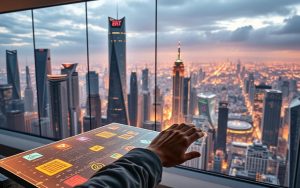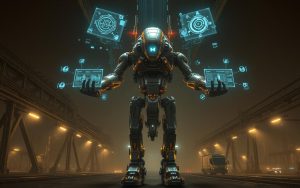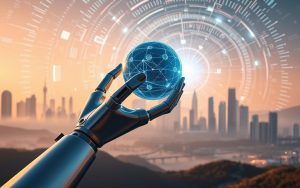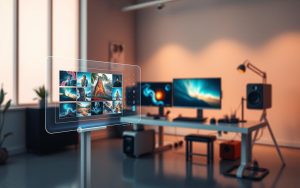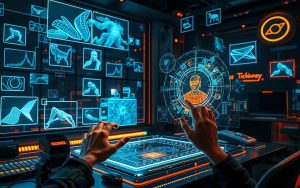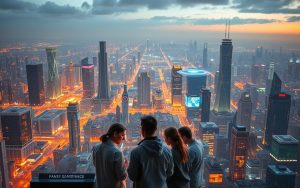Table of Contents
The world of art is undergoing a significant transformation with the advent of AI art generators. These sophisticated algorithms are capable of turning ordinary text prompts into stunning art, raising questions about the nature of creativity and art itself.
The emergence of AI-generated art is democratizing creativity, making it possible for individuals without traditional artistic training to produce remarkable works. This fusion of technology and art is redefining the creative landscape.
As we explore the capabilities of AI art generators, we must consider whether these algorithms are merely tools or potential collaborators in the creative process. This inquiry sets the stage for a deeper examination of the implications of AI-generated art on the future of creative expression.
The Evolution of Digital Creativity
As technology advances, the boundaries of artistic creation are being redefined. The journey from traditional art forms to AI-assisted creation has been transformative, impacting how we perceive and engage with art.
The Shift from Traditional to AI-Assisted Art Creation
The transition from traditional to digital art methods has been a gradual process. Initially, digital art was limited by the capabilities of early computer graphics. However, with advancements in technology, digital art has become more sophisticated, culminating in the development of AI art generators. These generators use complex algorithms to create art based on text descriptions, revolutionizing the creative process.
- Advances in machine learning have enabled AI systems to understand and replicate artistic styles.
- The computational power of modern computers has allowed for the processing of complex data required for AI art generation.
Why AI Art Generation Is Revolutionizing Creative Expression
AI art generation is democratizing creativity by making it accessible to everyone, regardless of their artistic background. This technology is not replacing human artists but rather augmenting their capabilities, providing new tools for expression. The result is a surge in creative output, as individuals can now bring their ideas to life without needing extensive artistic training.
The collaboration between humans and AI is redefining the creative process. By leveraging AI art generators, artists can explore new styles and ideas, pushing the boundaries of what’s possible in art. This synergy is leading to innovative artistic expressions that were previously unimaginable.
How AI Art Generators Transform Ideas Into Stunning Visuals
AI technology is now capable of generating breathtaking visuals from simple text prompts. This transformation is made possible by advanced AI models that have been trained on vast datasets of images and text.
The Technology Behind AI Image Generation
The core of AI art generators lies in their technology, which is rooted in machine learning architectures such as diffusion models and GANs (Generative Adversarial Networks). These systems learn to recognize patterns and relationships between text descriptions and image elements, enabling them to generate new, original visual content.
From Text Prompts to Visual Masterpieces
The process of turning text prompts into stunning art involves complex algorithms that interpret and translate textual descriptions into visual elements, colors, compositions, and styles. The quality of the generated image depends on the sophistication of the AI model and the specificity of the prompts.
The ability of AI art generators to produce diverse and high-quality visuals from ideas has opened new avenues for creative expression and innovation.
Top AI Art Generator Platforms in 2023
With advancements in AI technology, 2023 presents an exciting array of art generator platforms that are transforming the way we create and interact with digital art. The following sections will delve into two of the leading platforms: ImagineArt and OpenArt, examining their features, pricing, and capabilities.
ImagineArt: Features and User Experience
ImagineArt stands out with its comprehensive AI Tools Suite, empowering users to generate stunning AI art and captivating videos. The platform’s intuitive interface makes it accessible to both beginners and experienced users. To explore ImagineArt’s capabilities, you can try generating art with a prompt like:
ImagineArt’s cutting-edge AI technology allows for a wide range of creative possibilities, from still images to dynamic videos. Users have praised the platform for its ease of use and the high quality of the generated art. For more insights into the best AI art generators, you can visit this resource.
OpenArt: Pricing Plans and Capabilities
OpenArt offers a variety of plans tailored to different user needs, including a Free Plan, Starter Plan, Hobbyist Plan, and Pro Plan. The Free Plan includes up to 4 parallel generations and daily free credits on basic models, including Stable Diffusion XL. To experience OpenArt’s offerings, try a prompt like:
The platform’s tiered pricing structure allows users to choose a plan that suits their budget and creative requirements. For instance, the Pro Plan offers unlimited credits and the ability to create up to 32 parallel generations, making it ideal for heavy users and professionals.
Mastering the AI Art Creation Process
To unlock the full potential of AI art generators, understanding the intricacies of the creation process is essential. This involves not just familiarity with the tools, but also a deep understanding of how to guide the AI toward producing the desired artistic results.
Writing Effective Prompts for Optimal Results
Crafting effective prompts is crucial for obtaining high-quality AI-generated art. The choice of words, descriptive language, and the structure of the prompt all significantly influence the final output. Utilizing specific style descriptors, artistic references, and technical parameters can guide the AI toward achieving the desired visual outcomes. For instance, including details about the preferred style, such as “impressionist” or “surrealist,” can dramatically alter the generated art.
Common prompt patterns and formulas have been identified that consistently produce high-quality results across different AI art generator platforms. These include starting with a clear description of the subject, followed by the desired style or aesthetic, and concluding with any specific technical requirements or preferences.
Techniques for Refining and Enhancing AI-Generated Images
Once an initial image is generated, refining and enhancing it is often necessary to achieve the desired level of quality. Techniques for improving details and adjusting compositions can significantly enhance the final image. This may involve post-processing workflows that combine AI generation with traditional digital editing tools.
Iterative refinement is a key strategy, where initial generations are used as stepping stones toward more refined and precise visual outcomes. By adjusting prompts and applying image editing techniques, artists can achieve polished, professional-quality artwork. Maintaining artistic coherence across multiple generations is also crucial, especially when creating series of related images or illustrations for larger projects.
Practical Applications of AI Art Generators Across Industries
AI art generators are proving to be invaluable tools across different industries, enhancing creativity and productivity. These advanced tools are not only streamlining workflows but also opening up new avenues for creative expression.
For Professional Designers and Creative Agencies
Professional designers and creative agencies are leveraging AI art generators to accelerate their design processes. By using these tools, they can quickly generate concept art, explore different design directions, and create detailed illustrations. David Lee, a Graphic Designer, notes that ImagineArt saves him time and allows for a wider range of creative exploration.
For Marketing, Social Media, and Content Creation
In the realm of marketing and social media, AI art generators are being used to create engaging visuals that capture audience attention. Emily Brown, a Marketing Specialist, praises ImagineArt for helping her generate eye-catching visuals that resonate with her target audience, thereby enhancing her marketing campaigns.
For Personal Projects, Gaming, and Hobbyist Use
AI art generators are also popular among hobbyists and gamers who use them for personal projects. For instance, Peter Jackson, a gamer, uses ImagineArt to visualize characters and environments, making his gaming experience more immersive. Additionally, these tools are used for creating custom gifts and home décor, showcasing their versatility.
By adopting AI art generators, various industries are witnessing a significant boost in creativity and efficiency. Whether it’s for professional design, marketing campaigns, or personal projects, these tools are proving to be indispensable.
Commercial Usage and Intellectual Property Considerations
The growing demand for AI-generated art necessitates a thorough examination of commercial use and associated intellectual property concerns. As businesses increasingly adopt AI art generators, understanding the legal and ethical implications becomes crucial.
Understanding Licensing and Usage Rights
AI art generator platforms operate under various licensing models, such as the RAIL-M license used by Hotpot. Users must comply with the terms of service and observe responsible usage to avoid account termination or legal repercussions. It’s essential to understand that commercial use is allowed, but with specific restrictions: “do no harm” by not using AI to hurt others, incite violence, or break the law.
Best Practices for Commercial Implementation
To mitigate risks when using AI-generated images commercially, businesses should maintain proper documentation, be transparent with clients about the use of AI models, and implement risk mitigation strategies. This includes understanding the rights to the creations and ensuring compliance with intellectual property laws, which are evolving to address the unique challenges posed by AI-generated content.
By adopting best practices and staying informed about the legal landscape, businesses can effectively integrate AI-generated art into their commercial operations while minimizing legal exposure.
Addressing the Controversy: AI Art vs. Human Creativity
The intersection of AI and art has ignited a controversy that challenges our understanding of creativity and artistic value. As AI-generated art becomes increasingly sophisticated, it raises fundamental questions about the role of human artists in the creative process.
Authenticity and Artistic Value
The debate surrounding AI-generated art centers on issues of authenticity and artistic value. Critics argue that AI-generated art lacks the emotional depth and personal experience that a human artist brings to a piece. On the other hand, proponents argue that the creative process involved in crafting AI-generated art is itself a form of artistic expression. Joseph Schumpeter’s concept of “creative destruction” comes to mind, as AI art generators disrupt traditional notions of art creation.
Coexistence and Collaboration
Rather than replacing human artists, AI art generators can be seen as a tool that augments and expands human creative capabilities. Successful collaborations between human artists and AI systems have resulted in novel artistic expressions that wouldn’t be possible through either approach alone. By embracing this technology, artists can explore new frontiers in artwork creation and push the boundaries of what is possible.
Conclusion: Embracing the Future of Creative Technology
With AI art generators, the future of art is being rewritten, offering unprecedented opportunities for creative expression. These tools are not just transforming the way we create art; they’re democratizing access to artistic vision, enabling more people to bring their ideas to life regardless of traditional training or technical skill.
The evolution of AI art generators is likely to continue, with future capabilities and applications emerging in tandem with advancements in technology. As we move forward, it’s crucial to consider the implications of these tools on creative industries, including issues related to intellectual property and commercial usage, as discussed in studies such as those found on PMC.
Ultimately, AI art generators represent a new beginning for art creation, one that augments human creativity rather than replacing it. We encourage readers to explore these tools, experiment with their capabilities, and envision the future of art in this new technological landscape.
FAQ
What is the difference between AI-assisted art creation and traditional art?
AI-assisted art creation uses algorithms and machine learning models to generate art, whereas traditional art relies on human skill and creativity. AI-assisted art can produce unique and innovative results, but it still requires human input and guidance.
How do I choose the right AI image generation model for my project?
The choice of AI image generation model depends on your specific needs, such as the desired style, level of detail, and output quality. Research different models, like Stable Diffusion, and compare their features and results to find the best fit.
Can I use AI-generated images for commercial purposes?
Yes, but it’s essential to understand the licensing and usage rights associated with the AI art generator you use. Some platforms offer commercial licenses, while others may have restrictions or requirements for attribution.
How do I write effective prompts for AI art generation?
Writing effective prompts involves being specific, descriptive, and concise. Provide context and details about the desired image, including style, colors, and mood, to help the AI model produce the desired result.
Can AI art generators replace human creativity and artists?
AI art generators are designed to augment and collaborate with human creativity, not replace it. While AI can produce impressive results, human artists bring unique perspectives, emotions, and experiences to their work.
What are the benefits of using AI art generators for marketing and social media?
AI art generators can help create engaging, high-quality visuals quickly and efficiently, saving time and resources. They can also produce unique and attention-grabbing content that can help brands stand out on social media.



